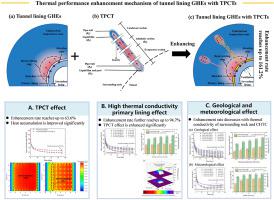Renewable Energy ( IF 9.0 ) Pub Date : 2023-05-29 , DOI: 10.1016/j.renene.2023.05.115
Chenglin Li , Guozhu Zhang , Suguang Xiao , Yehui Shi , Chenghua Xu , Yinjuan Sun

|
To date, the tunnel lining GHEs have encountered issues with the relatively low heat exchange rate and the rapid decline of heat exchange rate with time. This is because the huge heat accumulation around the tunnel lining GHEs obstructs the heat transfer between the absorber pipe and the surrounding rock during the GHEs operation. Hence, to improve the heat accumulation and enhance heat exchange rate, the two-phase closed thermosyphon (TPCT), an efficient device for long-distance heat transfer, was employed in the tunnel lining GHEs to build a thermally induced channel between absorber pipes and the surrounding rock, accelerating heat transfer between the absorber pipe and surrounding rock. The heat transfer model of the tunnel lining GHEs using TPCTs was built to analyze the thermal performance enhancement mechanism of tunnel lining GHEs using TPCTs for building cooling with different thermal conductivities of primary lining concrete and surrounding rock, and convective heat transfer coefficients (CHTCs) on tunnel internal walls. The results showed that throughout a 90-day operation, TPCTs dramatically boosted the heat injection rate of tunnel lining GHEs from 16.5 to 27.0 W/m2 with an increase of 63.6%. Thermal conductivities of the primary tunnel lining concrete have significant effects on the heat injection rates of the GHEs with TPCTs. The heat injection rates increased from 27.0 to 36.4 W/m2 as thermal conductivities of the concrete increased from 1.85 to 10.7 W/m K, and the enhancement rate ranged from 63.6% to 94.7% when compared to tunnel lining GHEs without TPCTs. The enhancement rate of tunnel lining GHEs with TPCTs decreased with increasing thermal conductivity of surrounding rock and CHTC, reaching up to 122.1% under the thermal conductivity of 1.4 W/m K and CHTC of 0 W/m2 K. Overall, TPCT greatly enhances the heat injection rate of tunnel lining GHEs, implying that it is a promising technology.
中文翻译:

隧道衬砌 GHEs 使用两相封闭式热虹吸管进行建筑物降温的热性能增强机制的数值研究
迄今为止,隧道衬砌GHE存在换热率相对较低且换热率随时间下降较快的问题。这是因为在 GHE 运行期间,隧道衬砌 GHE 周围大量的热量积累阻碍了吸热管与围岩之间的热传递。因此,为了改善热积累和提高热交换率,两相封闭式热虹吸管(TPCT)是一种有效的长距离传热装置,被用于隧道衬砌 GHEs 以在吸收管和吸收管之间建立热诱导通道。围岩,加速吸热管与围岩之间的传热。建立了TPCT隧道衬砌GHE的传热模型,分析了初衬混凝土和围岩导热系数不同的TPCT隧道衬砌GHE的热性能增强机制,以及对流传热系数(CHTC)的影响。隧道内墙。结果表明,在整个 90 天的运行过程中,TPCT 将隧道衬砌 GHE 的热注入率从 16.5 提高到 27.0 W/m2增长 63.6%。主要隧道衬砌混凝土的热导率对带有 TPCT 的 GHE 的热注入率有显着影响。当混凝土的热导率从 1.85 增加到 10.7 W/m K 时,热注入率从 27.0 增加到 36.4 W/m 2,与没有 TPCT 的隧道衬砌 GHE 相比,增强率从 63.6% 到 94.7 % 。TPCT隧道衬砌GHE的增强率随着围岩和CHTC导热系数的增加而降低,在导热系数为1.4 W/m K和CHTC为0 W/m 2 K时达到122.1%。总体而言,TPCT大大增强了隧道衬砌 GHE 的热注入率,这意味着它是一项很有前途的技术。































 京公网安备 11010802027423号
京公网安备 11010802027423号